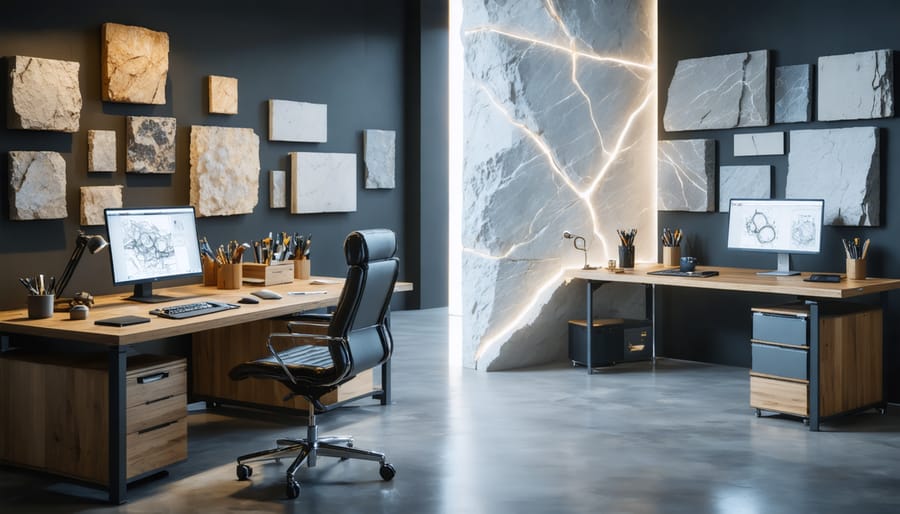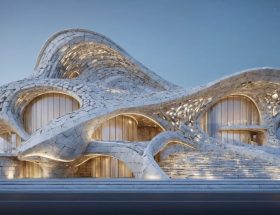Texture mapping revolutionizes how we visualize and design natural stone surfaces, bridging the gap between digital conception and physical reality. By precisely mapping high-resolution images onto 3D models, this groundbreaking technology enables designers to accurately preview how stone patterns, veining, and surface variations will appear in finished installations. Working alongside parametric design in stone architecture, texture mapping has transformed the way architects and designers approach material specification and visualization.
Unlike traditional rendering methods, modern texture mapping captures the subtle nuances of natural stone – from the crystalline sparkle of granite to the flowing veins of marble – with unprecedented accuracy. This precision allows stakeholders to make informed decisions about material selection, pattern matching, and installation planning before a single stone is cut. For professionals in architecture, design, and stone fabrication, mastering texture mapping has become essential for delivering projects that perfectly align with client expectations while minimizing material waste and installation errors.
What is AI-Driven Texture Mapping?
Traditional vs. AI-Powered Mapping
Traditional stone pattern mapping relied heavily on manual sketches, physical samples, and basic digital renderings, often leading to discrepancies between design vision and final implementation. These conventional methods, while functional, required extensive time and resources to visualize different pattern variations and surface treatments.
Modern advanced stone visualization techniques powered by AI have revolutionized this process. Machine learning algorithms can now instantly generate multiple pattern options, accurately predict how different stone types will appear in various lighting conditions, and even simulate natural variations in veining and coloration.
AI-powered mapping offers several key advantages: real-time pattern adjustment, precise material requirement calculations, and the ability to visualize complex installations before cutting begins. The technology can also identify optimal stone piece placement to minimize waste and maximize visual continuity, something traditionally left to experienced craftsmen’s judgment.
While AI streamlines the visualization process, it works best when combined with human expertise, creating a balanced approach that leverages both technological precision and artistic sensibility.
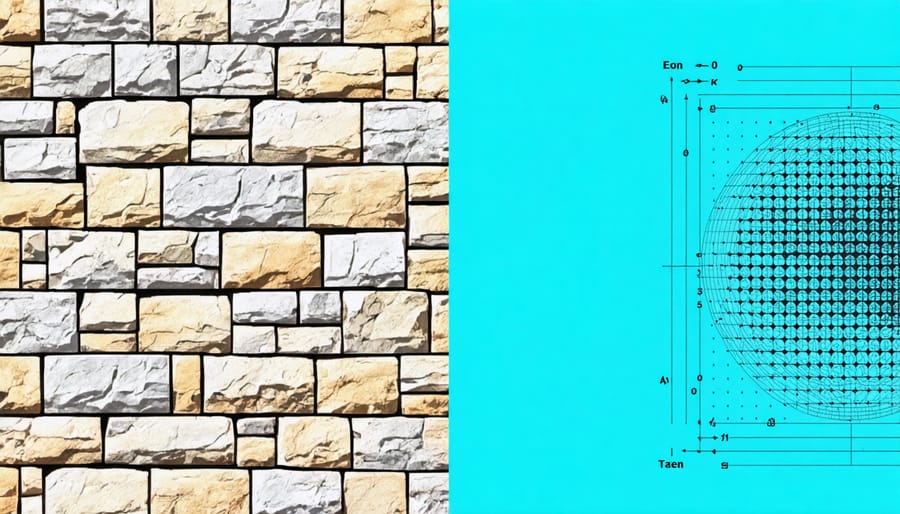
Key Benefits for Stone Design
Texture mapping delivers significant advantages for stone design professionals, transforming how we approach natural stone visualization and planning. The technology ensures exceptional accuracy in representing stone patterns, veining, and color variations, allowing designers to preview exactly how materials will appear in the final installation.
One of the most compelling benefits is the dramatic reduction in design time. What once took days of manual rendering can now be accomplished in hours, enabling faster project turnaround and more efficient client approvals. Designers can quickly experiment with different stone varieties and layouts without the need for physical samples or mock-ups.
The creative possibilities are equally impressive. Texture mapping allows for seamless pattern matching across large surfaces, precise book-matching of stone slabs, and realistic visualization of complex geometric patterns. This technology enables designers to showcase how natural stone will interact with lighting, viewing angles, and surrounding materials before installation begins.
For clients, this means clearer communication, fewer surprises, and more confident decision-making. The ability to virtually “see” the final result helps prevent costly mistakes and ensures satisfaction with the finished project.
Real-World Applications
Residential Projects
Texture mapping has revolutionized residential design, particularly in visualizing natural stone applications before installation. In a recent Manhattan penthouse renovation, designers used texture mapping to showcase different marble options for the kitchen countertops. The technology allowed homeowners to preview how Calacatta gold marble would interact with their lighting scheme and existing cabinetry, leading to more confident decision-making.
Bathrooms present another compelling use case. A Beverly Hills project demonstrated how texture mapping helped visualize book-matched onyx panels in a master bathroom. The technology accurately displayed the stone’s translucent properties and how it would appear when backlit, preventing costly installation adjustments.
In kitchen applications, texture mapping proves invaluable when planning complex installations. A Mediterranean-style home in Florida used the technology to preview how different granite patterns would flow across multiple surfaces, including a waterfall island and full-height backsplash. This visualization helped identify potential pattern mismatches before cutting the stone.
Residential architects are increasingly incorporating texture mapping into their client presentations. A Colorado mountain home project utilized the technology to show how various slate textures would appear on exterior walls under different weather conditions and times of day. This level of detail helped the homeowners understand how their material choices would perform in real-world conditions.
These residential applications demonstrate how texture mapping bridges the gap between imagination and reality in stone design. The technology reduces costly mistakes, improves client communication, and ensures the final installation matches expectations, making it an essential tool in modern home design.
Commercial Applications
Texture mapping has revolutionized commercial interior design, transforming how natural stone is showcased in prestigious spaces. In luxury hotels, designers utilize digital stone design solutions to create stunning feature walls that combine multiple stone varieties in intricate patterns, maximizing visual impact while optimizing material usage.
Corporate offices increasingly employ texture mapping to achieve sophisticated stone installations in lobbies and conference rooms. For example, the Goldman Sachs headquarters in New York features precisely mapped marble panels that create seamless transitions between walls and columns, demonstrating how technology enables perfect pattern matching across complex architectural elements.
Public spaces like museums and transportation hubs showcase large-scale applications of texture mapping. The Dubai International Airport’s Terminal 3 incorporates mapped stone patterns across its vast interior surfaces, creating a cohesive design language throughout the space while maintaining practical considerations for maintenance and durability.
Shopping centers and retail environments benefit from texture mapping’s ability to create custom stone layouts that guide foot traffic and enhance brand identity. High-end retail chains often use mapped stone patterns to create signature looks that can be replicated across multiple locations while accounting for varying spatial dimensions.
Healthcare facilities utilize texture mapping to create calming environments with natural stone elements that meet strict hygiene requirements. Modern hospitals incorporate mapped stone patterns in waiting areas and corridors, carefully positioning seams and transitions to maintain both aesthetic appeal and practical functionality.
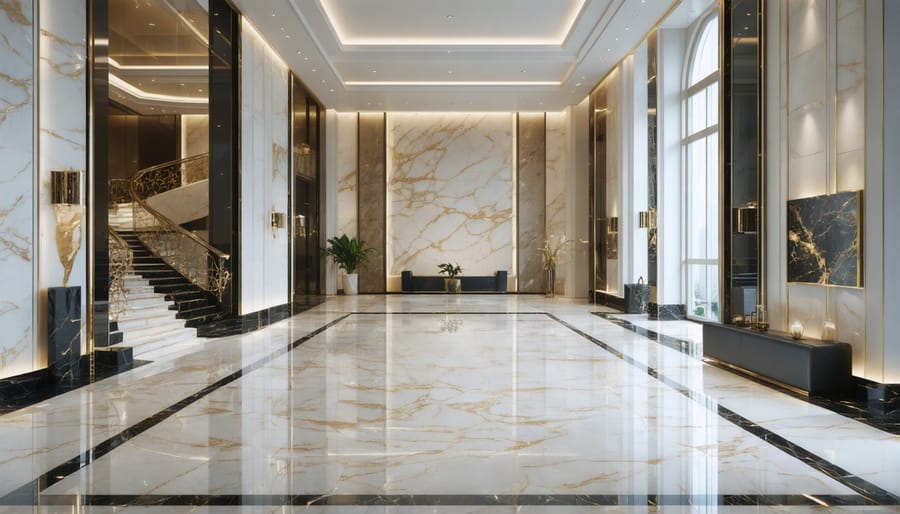
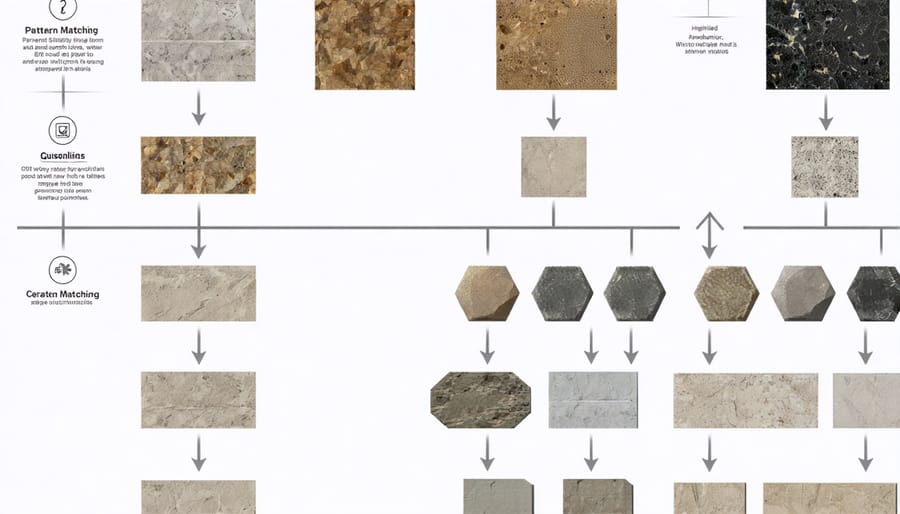
Implementation Process
Digital Scanning and Analysis
Digital scanning technology has revolutionized the way we capture and analyze natural stone textures. Using high-resolution scanners and specialized cameras, technicians can now create detailed digital representations of stone surfaces with unprecedented accuracy. These devices capture not only the visual patterns but also the subtle variations in depth, color, and surface texture that make each stone unique.
The scanning process typically begins with surface preparation, where the stone is cleaned and positioned for optimal capture. Advanced 3D scanners use multiple angles and lighting conditions to record every detail, from minor veining to larger geological formations. This data is then processed through sophisticated software that converts the scanned information into detailed digital maps.
Modern scanning systems can capture surface details down to microscopic levels, measuring variations as small as 0.1 millimeters. This precision allows for exact replication of natural stone patterns in digital format, which is crucial for accurate texture mapping applications. The collected data includes both color information and height maps, creating a complete digital profile of the stone’s surface characteristics.
The analysis phase involves processing this raw data through specialized software that identifies key pattern features, material properties, and unique characteristics. This information can then be used to create highly accurate texture maps for various applications, from architectural visualization to manufacturing templates.
Pattern Matching and Visualization
Modern AI-powered texture mapping systems employ sophisticated pattern matching algorithms to create seamless, natural-looking stone surfaces. These systems analyze high-resolution photographs of actual stone slabs, identifying distinctive patterns, color variations, and mineral formations. Through machine learning, the software understands how different stone patterns naturally flow and connect.
The visualization process begins by breaking down the stone’s texture into smaller components, mapping recurring elements while maintaining the natural randomness found in real stone. AI algorithms then create multiple variations of these patterns, ensuring that repeated sections don’t appear obvious or artificial. This is particularly valuable when mapping large surfaces where pattern repetition could otherwise be noticeable.
Advanced visualization tools allow designers to preview how the mapped texture will appear on complex 3D surfaces before implementation. These tools can simulate different lighting conditions, viewing angles, and surface finishes, providing a realistic preview of the final result. The technology also helps identify potential problem areas where patterns might not align properly, allowing for adjustments before physical application.
For natural stone applications, these tools are especially valuable in creating virtual mockups for clients, showing how book-matched marble will look on a wall, or demonstrating how different stone patterns will flow across curved surfaces. This technology significantly reduces the risk of costly mistakes and ensures client expectations align with the final installation.
Future Implications
The future of texture mapping in stone design is being dramatically shaped by artificial intelligence and advanced computational technologies. As we witness rapid architectural stone innovations, several emerging trends are set to transform the industry.
Machine learning algorithms are becoming increasingly sophisticated in their ability to analyze and replicate natural stone patterns. This advancement means designers will soon be able to generate unlimited unique stone textures that maintain the authenticity of natural materials while offering unprecedented customization options. These AI-driven systems can learn from vast databases of real stone surfaces, understanding the subtle variations and characteristics that make natural stone so appealing.
Real-time visualization technology is evolving to provide instantaneous texture mapping adjustments, allowing designers to experiment with different stone patterns and arrangements more efficiently. This capability, combined with augmented reality applications, will enable clients to visualize stone installations in their actual space before any physical work begins.
3D printing technology is also advancing rapidly, with new systems capable of reproducing stone textures with remarkable accuracy. This development suggests a future where designers can create prototypes with exact texture specifications, leading to more precise and cost-effective stone installations.
Sustainability considerations are driving innovation in texture mapping technology. New algorithms are being developed to optimize stone cutting patterns, reducing waste and maximizing material efficiency. These systems can analyze stone slabs and suggest the most economical cutting patterns while maintaining aesthetic consistency.
As computational power continues to increase, we can expect to see more sophisticated texture mapping tools that incorporate physical properties of stone materials, enabling more accurate predictions of how different stone types will weather and age over time. This advancement will help architects and designers make more informed decisions about material selection and placement, ensuring longer-lasting and more beautiful stone installations.
AI-powered texture mapping has revolutionized the natural stone design industry, offering unprecedented possibilities for visualization, customization, and efficiency. By combining advanced imaging technology with machine learning algorithms, designers and architects can now create highly accurate digital representations of stone surfaces, leading to more informed design decisions and better project outcomes.
The integration of AI texture mapping has streamlined the selection process, reduced material waste, and enabled more precise cost estimations. Clients can now visualize their projects with photorealistic accuracy before any physical work begins, while manufacturers can optimize their production processes and inventory management.
Looking ahead, the continued evolution of AI texture mapping technology promises even more innovative applications in natural stone design. From enhanced material matching capabilities to automated quality control systems, these advancements will continue to transform how we approach stone design and installation. As the technology becomes more accessible and refined, it will undoubtedly play an increasingly vital role in shaping the future of architectural and interior design, making natural stone applications more efficient, sustainable, and creatively boundless than ever before.

